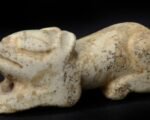In a remarkable paleontological discovery, scientists have unearthed the fossilized remains of a Guizhouichthyosaurus, a massive marine reptile from the Triassic period, with an equally large prey in its stomach. This find, dating back approximately 240 million years, provides unprecedented insight into the diet and predatory behavior of these ancient creatures. The Guizhouichthyosaurus, measuring about 16 feet in length, was found with a 13-foot-long thalattosaur lodged in its gut, challenging previous assumptions about its feeding habits.
Uncovering the Fossil
The discovery of the Guizhouichthyosaurus fossil in Guizhou province, China, has captivated the scientific community. The fossil was first unearthed in 2010, but it wasn’t until recently that researchers realized the significance of the find. The ichthyosaur’s stomach contents were remarkably well-preserved, allowing scientists to identify the remains of a thalattosaur, a large marine reptile that lived during the same period.
This discovery is particularly significant because it provides direct evidence of predation on large prey by ichthyosaurs. Previously, it was believed that these marine reptiles primarily fed on smaller, softer prey like cephalopods. The presence of a large thalattosaur in the ichthyosaur’s stomach suggests that these predators were capable of taking down much larger animals, indicating a more complex and varied diet than previously thought.

The fossil also offers a rare glimpse into the behavior of ancient marine ecosystems. The fact that the ichthyosaur died shortly after consuming its massive meal suggests that it may have bitten off more than it could chew. This scenario provides valuable information about the risks and challenges faced by these ancient predators in their quest for survival.
The Significance of the Find
The Guizhouichthyosaurus fossil is a groundbreaking discovery that has far-reaching implications for our understanding of prehistoric marine life. The size and condition of the prey found in the ichthyosaur’s stomach provide concrete evidence that these creatures were apex predators, capable of hunting and consuming large animals. This challenges previous assumptions about their feeding habits and ecological role.
The discovery also sheds light on the evolutionary history of marine reptiles. By studying the fossilized remains of both the predator and its prey, scientists can gain insights into the adaptations and behaviors that allowed these creatures to thrive in their environments. This information is crucial for understanding the broader patterns of evolution and extinction that have shaped the history of life on Earth.
Furthermore, the find highlights the importance of interdisciplinary collaboration in paleontology. The successful identification and analysis of the fossil required expertise from multiple fields, including geology, biology, and advanced imaging techniques. This collaborative approach has opened new avenues for research and has the potential to uncover even more remarkable discoveries in the future.
Future Research and Implications
The discovery of the Guizhouichthyosaurus fossil has paved the way for further research into the predatory behavior of ancient marine reptiles. Scientists are now exploring the possibility of finding additional fossils that could provide more evidence of similar predation events. Such discoveries could help to build a more comprehensive picture of the ecological dynamics of the Triassic period.
In addition to expanding our knowledge of ancient marine ecosystems, this research has broader implications for the field of paleontology. The techniques used to analyze the Guizhouichthyosaurus fossil, including advanced imaging and 3D modeling, are at the forefront of scientific innovation. These methods can be applied to other fossils, potentially revealing new information about the behavior and biology of extinct species.
The findings also underscore the importance of preserving and studying fossil sites around the world. Each new discovery has the potential to transform our understanding of the past and provide valuable insights into the history of life on Earth. As researchers continue to uncover the secrets of ancient marine predators, we can look forward to a deeper and more nuanced understanding of our planet’s prehistoric past.













